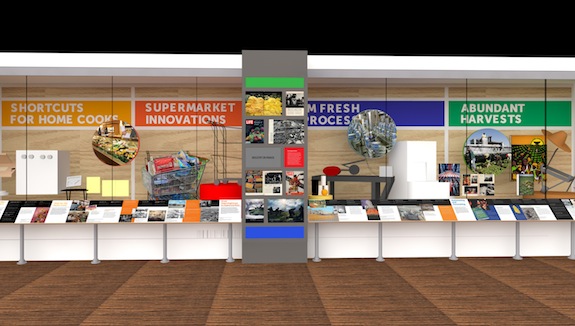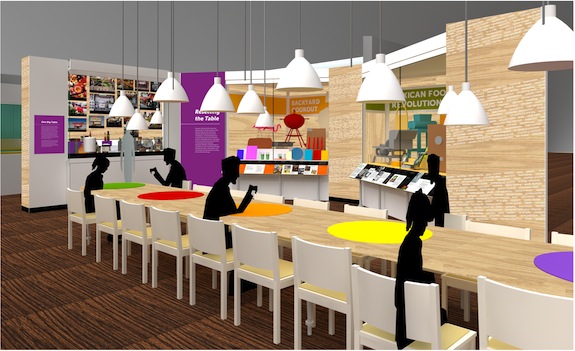Sneak Peek at “FOOD: Transforming the American Table, 1950-2000″
Set to open Nov. 20, the new exhibit explores the diversity and development of American food cultures
![]()

The incredible changes in food production and consumption in the second half of the 20th century provide a proverbial feast for thought in the upcoming exhibit. Courtesy of the American History Museum
You can thank the U.S. ballistic missile program for CorningWare’s ubiquitous, simple white dishes with the dainty blue blooms painted on like pressed wildflowers. “That’s a complete Space Age material,” says Cory Bernat, one of the curators on the American History Museum’s upcoming exhibit “Food: Transforming the American Table, 1950-2000.” Touring the space where the exhibit will open next month, Bernat points to the place where the CorningWare baking dish will take its place of honor.
“It really changed people’s lives and I know this because the dish in the show belonged to my mother,” says Bernat. Humble, unassuming objects like a CorningWare dish, Bernat argues, actually represent major transformations in the way Americans cook and eat.

An illustration of the exhibit’s “New and Improved” display showcases technological changes in cooking and food production. Illustration courtesy of the American History Museum.
Bernat says the exhibit is full of these transformational stories, including the rise of frozen concentrated orange juice. As a product specially developed just after WWII and popularized by modern marketing, Bernat says, “To me, that’s a pretty quintessential story for this exhibit.” She also points to appliances like the George Foreman grill, which now seem minor, but at the time represented a significant shift; in this case, using a manly personality to market both health and cooking to a new audience.
These items are just a small part of the story. The show will also cover what it’s calling the Mexican food revolution, the Good Food movements, food on the go, advancements in the vineyard, the rise and fall of kitchen appliances and other such topics.

The section titled “Resetting the Table,” will feature the rise of Mexican food in America. Illustration courtesy of the American History Museum.
Starting with a trip past the home kitchen of Julia Child, the exhibit succeeds in showing the diversity of food cultures and the many forces that shape our current diets. Across from the display case of Good Food movements–complete with Alice Water’s paraphrenalia and photographs from the Black Panthers’ food distribution program–sits the food-on-the-go case. Bernat points out that the advent of fast food culture actually began in California alongside early iterations of Good Food movements. In-N-Out Burger, founded in 1948 in Baldwin Park, California, will be represented by two lap mats, which allowed people to dine in their cars.
That California’s car culture as well as its reputation for agricultural abundance made it home to in-car dining on the one hand and local food movements on the other speaks to the ways in which food can both unite and divide.

And because the story is far from over, the “Open Table” hopes to inspire conversation. Illustration courtesy of the American History Museum.
At the heart of the exhibit sits a large table with an array of nutritional guides and pyramids from over the years presented on rotating wheels. The charts include the standard guides we were all shown growing up as well as less conventional ones, including a vegetarian’s guide, charts from international diets and other variations. Billed as the “Open Table,” it is meant to encourage conversation about our changing relationship to food.
Set to open November 20th, just in time for Thanksgiving, the exhibit will show the complicated reality of a simple question: what’s for dinner?
/https://tf-cmsv2-smithsonianmag-media.s3.amazonaws.com/accounts/headshot/Leah-Binkovitz-240.jpg)
/https://tf-cmsv2-smithsonianmag-media.s3.amazonaws.com/accounts/headshot/Leah-Binkovitz-240.jpg)